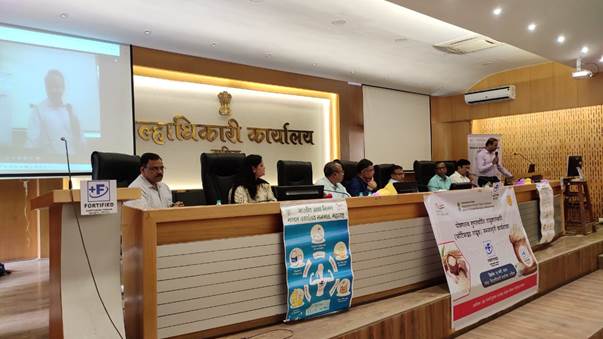Prominent among the experts who addressed the concerns of the people were -Dr S. Nair, Dr. H. Gandhi, MS University, Vadodara, Dr. K. Yadav, Dr. T. Achary, AIIMS, New Delhi, Dr. Raghvendra Singh, MAMC, New Delhi, Dr N. Tayade, PDM Medical College, Amravati, Dr N.Bawa, Nandurbar, Dr. R. Mainde, NetProFan, Nagpur, Dr. M. Ruikar, AIIMS, Raipur, Dr. S. Aggarwal, Dept of Health, Chhattisgarh, Dr. U. Joshi, DG, Sickle Cell Institute, Chhattisgarh, Dr. B.Sahu, Dr. K. Singh, Dr. S.K. Makram, Scientist, Krishi Vikash Kendra, Indira Gandhi Krishi Vishwavidyala, Kanker, Dr. D. Kumar, Astt. Professor, RIMS, Ranchi, Dr. A. Chatterjee and Dr. D. Pandey, AIIMS, Bhopal. The experts made presentations on fortified staples and its effect on Hemoglobinopathies such as Thalassemia and Sickle Cell Anemia.
The presentations were followed by panel discussions, Q&A sessions by technical experts and officials from D/o Food & PD and FCI.
The experts highlighted the benefits of fortified rice for the public and addressed their concerns and misgivings of the people and local media.
Fortification is the process of adding Fortified Rice Kernels (FRK), containing FSSAI prescribed micronutrients (Iron, Folic Acid, Vitamin B12) to normal Rice (Custom Milled Rice) in the ratio of 1:100 (Mixing 1 Kg of FRK with 100 Kg custom milled rice). Fortified rice is nearly identical to traditional rice in aroma, taste, and texture. This process is done in the rice mills at the time of milling of rice.

Rice fortification ecosystem has been enhanced significantly on boarding rice millers, FRK manufacturers, industries and other stakeholders for production and supply of fortified rice to meet the target requirement. There are more than 9000 rice mills in the country which have installed blending infrastructure for production of fortified rice and their cumulative monthly production capacity is around 60 LMT which is increased by more than 4 times since last year.
Fortification of rice is found to be a cost-effective and complementary strategy to increase vitamin and mineral content in diets with low turnaround time (TAT) and a step towards nutritional security and helps in fighting anemia and malnutrition in the country. This strategy is implemented in many parts of the world.
*****
AD/NS